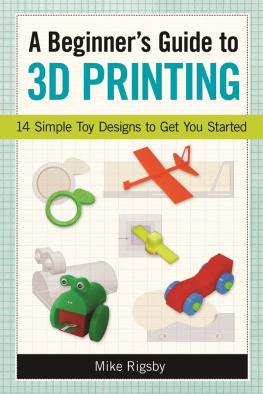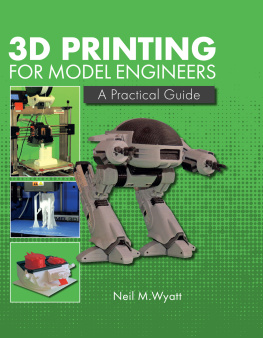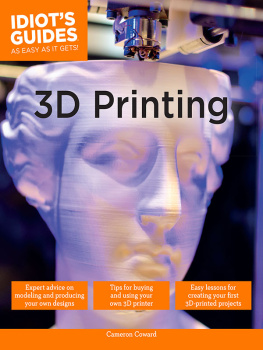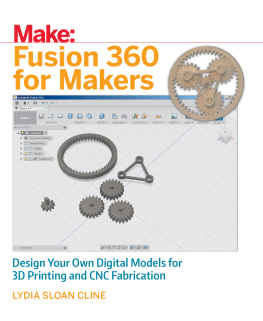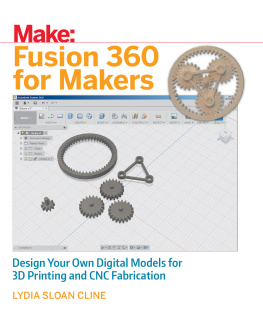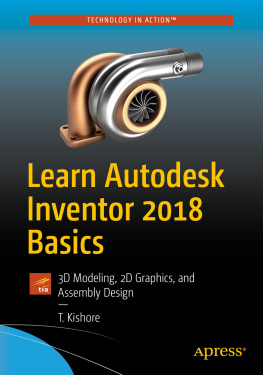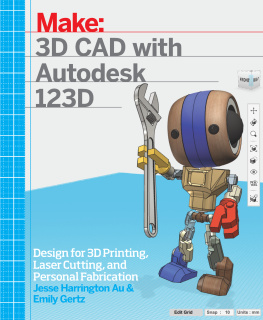Copyright 2014 by Mike Rigsby
All rights reserved
Published by Chicago Review Press Incorporated
814 North Franklin Street
Chicago, Illinois 60610
ISBN 978-1-56976-197-7
Library of Congress Cataloging-in-Publication Data
Rigsby, Mike, 1950 author.
A beginners guide to 3D printing : 14 simple toy designs to get you started / Mike Rigsby.
pages cm
Summary: A Beginners Guide to 3D Printing is the perfect resource for those who would like to experiment with 3D design and manufacturing, but have little or no technical experience with the standard software. Author Mike Rigsby leads readers step-by-step through 15 simple toy projects, each illustrated with screen caps of Autodesk 123D Design, the most common free 3D software available. The projects are later described using Sketchup, another free popular software package. Beginning with basics projects that will take longer to print than design, readers are then given instruction on more advanced toys, including a baking-powder submarine, a train with expandable track, a multipiece airplane, a rubber band-powered car, and a noise-making push toy with froggy eyes. Once trained in the basics of computer-aided design, readers will be able to embark on even more elaborate projects of their own creation Provided by publisher.
ISBN 978-1-56976-197-7 (paperback)
1. Three-dimensional printing. 2. CAD/CAM systems. 3. Rapid prototyping. 4. Computer-aided design. 5. SketchUp. I. Title. II. Title: Beginners guide to three-D printing.
TS155.6.R54 2014
621.988dc23
2014026069
Cover design: Sarah Olson
Interior design: Rattray Design
Printed in the United States of America
5 4 3 2 1
CONTENTS
GETTING STARTED
Moving from an idea to a physical object is the promise of 3D printing.

If you want to design three-dimensional objects on the computer, then do it. With access to a 3D printer and some free design software, your first project will take less than one minute.
Look around. Most of the objects you see started as a box or a can, often with holes drilled in them or pieces sticking out. You can make things like that.
Do you have an idea for a new invention? You can take the next step in realizing that potential. Using an apprentice approachdo the work and learning will occuryou will go through every step in the design of 15 toys. Whether your goal is building toys, making stuff, or learning about 3D printing, going through the projects will show you how to create and manipulate 3D objects.
Consumer-grade (read: affordable) 3D printers create objects by extruding layers of hot plastic, sort of like a computer-controlled hot glue gun. The most commonly used plastics are ABS (the same material as in Legos) and PLA (a biodegradable alternative). PLA printers tend to be easier to use, since they dont require heated beds or temperature-controlled chambers.
Expensive commercial printers can produce objects using metal, food, or biological material. The expiration of a key laser sintering patent in 2014 (US patent number 5,597,589) opens the door to improvements in speed, cost, quality, and material capabilities of 3D printers.
Printing takes time. A decorative ring for your finger will require 10 to 15 minutes to print. Similar to paper printers, a 3D printer has different quality levels for the printed product. A less detailed object prints faster. Depending on the printer settings, the inside areas of a printed object can be hollow (0 percent fill), solid (100 percent fill), or anywhere between. The printers default settings are normally adequate for the projects in this book.
If you are not ready to purchase a printer, there are several ways to produce a real-world object from a computer-generated file for a small fee. Some libraries have 3D printers available for their patrons. Autodesk 123D Design has a Send to 3D Print Web Service button built into the software. Commercial 3D printing services (search the web for 3D printing service) can even produce your items in silver. To find a local printer, visit www.3dhubs.com, which lists thousands of users worldwide who are willing to print projects.
Downloading the Software
Before you begin, you will need to download and install free design software for Windows or Mac: either 123D Design (www.123dapp.com/design) or SketchUp (www.sketchup.com). The more detailed instructions in this book use 123D Design. Follow the instructions and install the software on your computer.
Each program is available for both Windows and Mac computers. The 123D Design instructions were prepared on a Windows laptop computer (the lowest-cost laptop from a big box store) and the SketchUp instructions were prepared on a Mac laptop, but they should work with either operating system. Small differences between the Windows and Mac versionsor future updates to the softwaremay change the programs configuration slightly. If this happens, look for an option with the same or a similar name.
For SketchUp, you will need to do two additional setup tasks. When installed, open the program. Select Choose Template and select WoodworkingMillimeters then left-click Start Using SketchUp (at the lower right corner of the box with the template selections).
One time only, you will need to do this step. Go to the top of the screen, find the second icon from the right (SketchUp Extension), and left-click with your mouse. In the white box in the upper right corner, type STL. Left-click on the red magnifying glass to the right of the white box. From the results, left-click SketchUp STL. On the next screen, choose Install. Next, choose Accept. Click on Install and you are ready.
Files for all of the projects in this book are available at no cost through the website www.MisterEngineer.com. More than 100,000 designs for printing are available (at no charge) through a website for sharing things, www.Thingiverse.com.
Domino-Style Blocks

This is an introductory project so you can get acquainted with the basics of 3D design. To create domino-style blocks using 123D Design, you will select a box and describe the dimensions of a domino-shaped block.
Go to Primitives and drop down to Box.

Left-click and release. A cube will appear. Move the cursor to the lower left area of the screen.

Type 8, then press the Tab key. Type 50, then press the Tab key. Type 25. Press Enter. This will create a box that is 8 mm by 50 mm by 25 mm.

Move the cursor to 123D in the upper left corner. On the drop-down menu, find Export STL and you are ready to print your first project.

